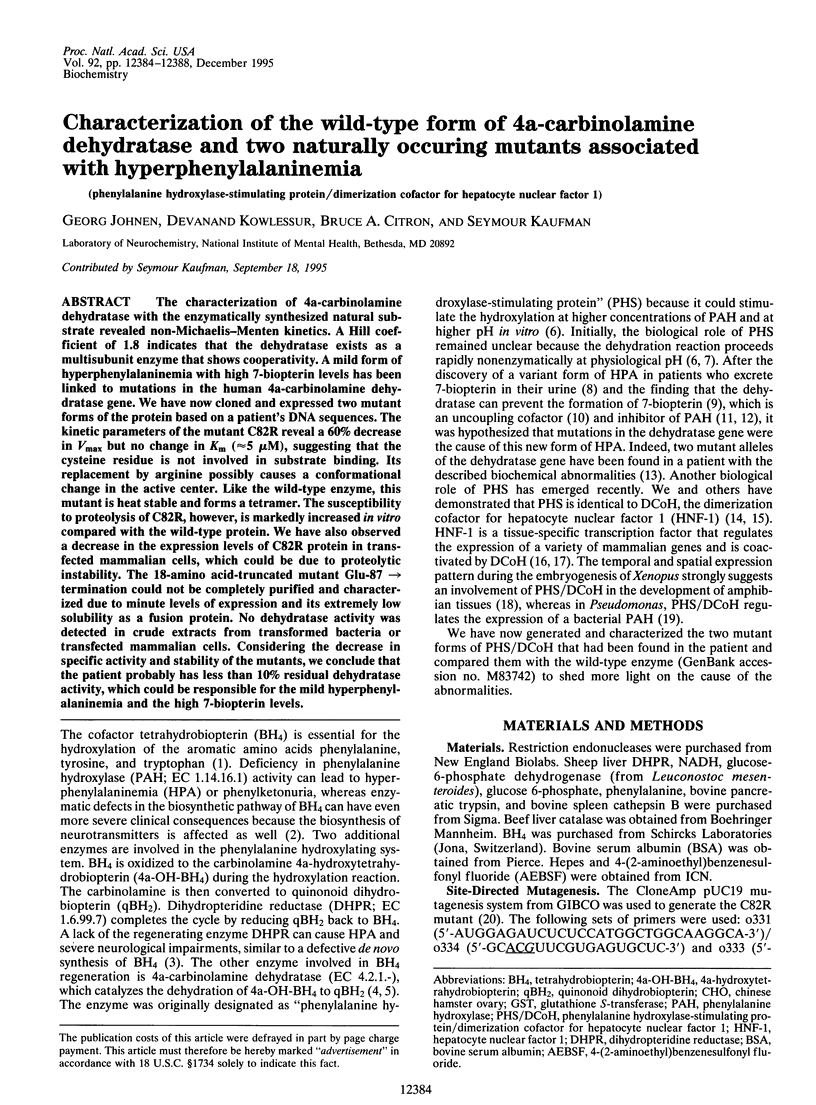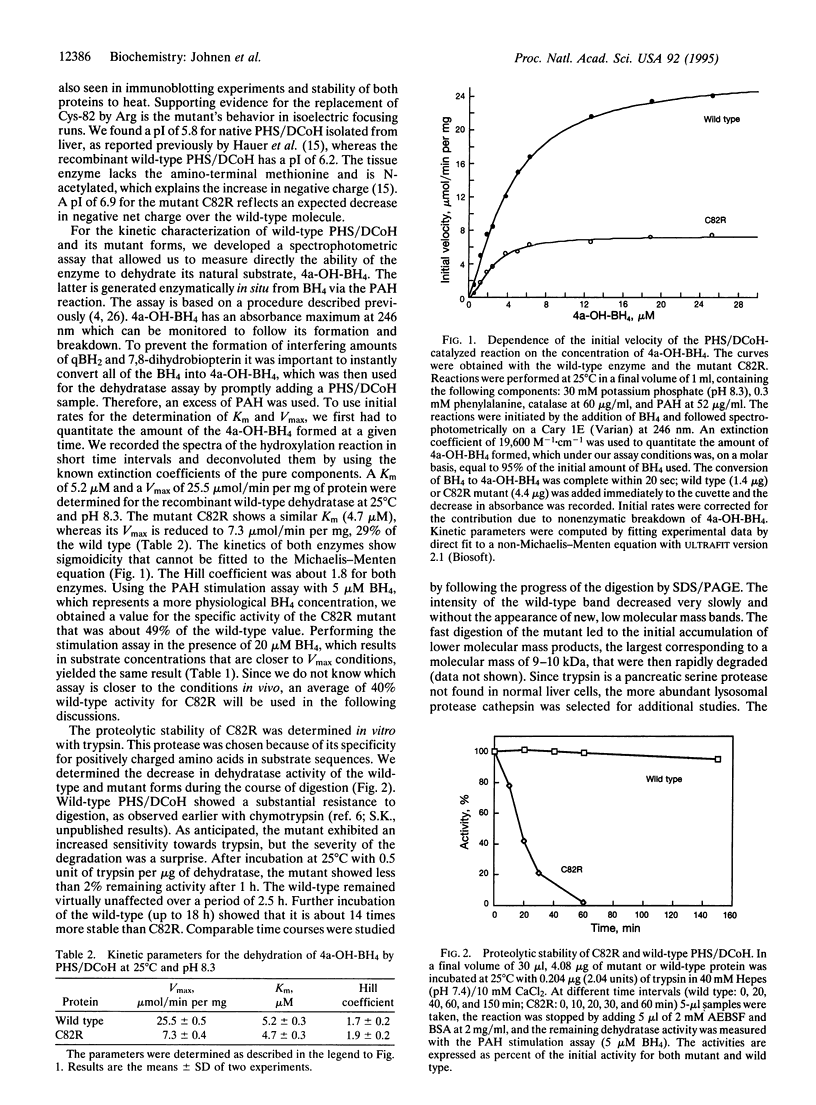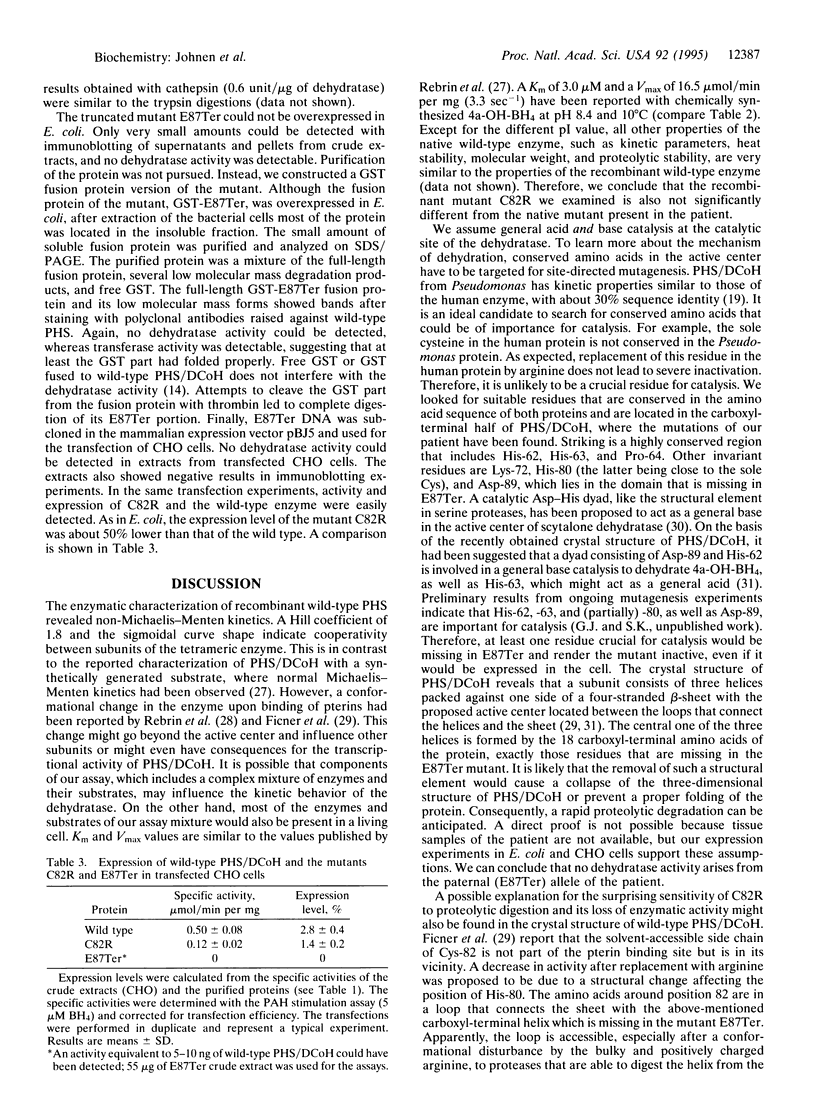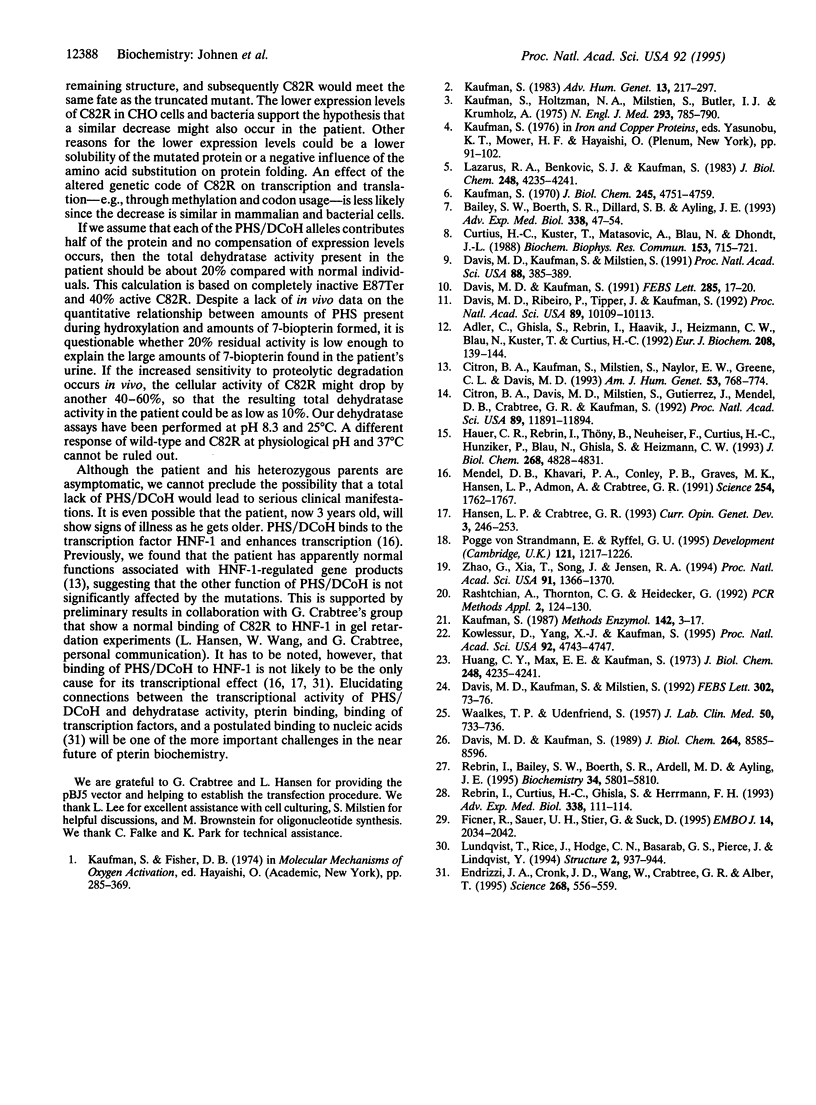Abstract
The characterization of 4a-carbinolamine dehydratase with the enzymatically synthesized natural substrate revealed non-Michaelis-Menten kinetics. A Hill coefficient of 1.8 indicates that the dehydratase exists as a multisubunit enzyme that shows cooperativity. A mild form of hyperphenylalaninemia with high 7-biopterin levels has been linked to mutations in the human 4a-carbinolamine dehydratase gene. We have now cloned and expressed two mutant forms of the protein based on a patient's DNA sequences. The kinetic parameters of the mutant C82R reveal a 60% decrease in Vmax but no change in Km (approximately 5 microM), suggesting that the cysteine residue is not involved in substrate binding. Its replacement by arginine possibly causes a conformational change in the active center. Like the wild-type enzyme, this mutant is heat stable and forms a tetramer. The susceptibility to proteolysis of C82R, however, is markedly increased in vitro compared with the wild-type protein. We have also observed a decrease in the expression levels of C82R protein in transfected mammalian cells, which could be due to proteolytic instability. The 18-amino acid-truncated mutant GLu-87--> termination could not be completely purified and characterized due to minute levels of expression and its extremely low solubility as a fusion protein. No dehydratase activity was detected in crude extracts from transformed bacteria or transfected mammalian cells. Considering the decrease in specific activity and stability of the mutants, we conclude that the patient probably has less than 10% residual dehydratase activity, which could be responsible for the mild hyperphenylalaninemia and the high 7-biopterin levels.
Full text
PDF




Selected References
These references are in PubMed. This may not be the complete list of references from this article.
- Adler C., Ghisla S., Rebrin I., Haavik J., Heizmann C. W., Blau N., Kuster T., Curtius H. C. 7-substituted pterins in humans with suspected pterin-4a-carbinolamine dehydratase deficiency. Mechanism of formation via non-enzymatic transformation from 6-substituted pterins. Eur J Biochem. 1992 Aug 15;208(1):139–144. doi: 10.1111/j.1432-1033.1992.tb17167.x. [DOI] [PubMed] [Google Scholar]
- Bailey S. W., Boerth S. R., Dillard S. B., Ayling J. E. The mechanism of cofactor regeneration during phenylalanine hydroxylation. Adv Exp Med Biol. 1993;338:47–54. doi: 10.1007/978-1-4615-2960-6_9. [DOI] [PubMed] [Google Scholar]
- Citron B. A., Davis M. D., Milstien S., Gutierrez J., Mendel D. B., Crabtree G. R., Kaufman S. Identity of 4a-carbinolamine dehydratase, a component of the phenylalanine hydroxylation system, and DCoH, a transregulator of homeodomain proteins. Proc Natl Acad Sci U S A. 1992 Dec 15;89(24):11891–11894. doi: 10.1073/pnas.89.24.11891. [DOI] [PMC free article] [PubMed] [Google Scholar]
- Citron B. A., Kaufman S., Milstien S., Naylor E. W., Greene C. L., Davis M. D. Mutation in the 4a-carbinolamine dehydratase gene leads to mild hyperphenylalaninemia with defective cofactor metabolism. Am J Hum Genet. 1993 Sep;53(3):768–774. [PMC free article] [PubMed] [Google Scholar]
- Curtius H. C., Kuster T., Matasovic A., Blau N., Dhondt J. L. Primapterin, anapterin, and 6-oxo-primapterin, three new 7-substituted pterins identified in a patient with hyperphenylalaninemia. Biochem Biophys Res Commun. 1988 Jun 16;153(2):715–721. doi: 10.1016/s0006-291x(88)81153-7. [DOI] [PubMed] [Google Scholar]
- Davis M. D., Kaufman S. 7-Tetrahydrobiopterin is an uncoupled cofactor for rat hepatic phenylalanine hydroxylase. FEBS Lett. 1991 Jul 8;285(1):17–20. doi: 10.1016/0014-5793(91)80714-e. [DOI] [PubMed] [Google Scholar]
- Davis M. D., Kaufman S. Evidence for the formation of the 4a-carbinolamine during the tyrosine-dependent oxidation of tetrahydrobiopterin by rat liver phenylalanine hydroxylase. J Biol Chem. 1989 May 25;264(15):8585–8596. [PubMed] [Google Scholar]
- Davis M. D., Kaufman S., Milstien S. Conversion of 6-substituted tetrahydropterins to 7-isomers via phenylalanine hydroxylase-generated intermediates. Proc Natl Acad Sci U S A. 1991 Jan 15;88(2):385–389. doi: 10.1073/pnas.88.2.385. [DOI] [PMC free article] [PubMed] [Google Scholar]
- Davis M. D., Kaufman S., Milstien S. Distribution of 4a-hydroxytetrahydropterin dehydratase in rat tissues. Comparison with the aromatic amino acid hydroxylases. FEBS Lett. 1992 May 4;302(1):73–76. doi: 10.1016/0014-5793(92)80288-r. [DOI] [PubMed] [Google Scholar]
- Davis M. D., Ribeiro P., Tipper J., Kaufman S. "7-tetrahydrobiopterin," a naturally occurring analogue of tetrahydrobiopterin, is a cofactor for and a potential inhibitor of the aromatic amino acid hydroxylases. Proc Natl Acad Sci U S A. 1992 Nov 1;89(21):10109–10113. doi: 10.1073/pnas.89.21.10109. [DOI] [PMC free article] [PubMed] [Google Scholar]
- Endrizzi J. A., Cronk J. D., Wang W., Crabtree G. R., Alber T. Crystal structure of DCoH, a bifunctional, protein-binding transcriptional coactivator. Science. 1995 Apr 28;268(5210):556–559. doi: 10.1126/science.7725101. [DOI] [PubMed] [Google Scholar]
- Ficner R., Sauer U. H., Stier G., Suck D. Three-dimensional structure of the bifunctional protein PCD/DCoH, a cytoplasmic enzyme interacting with transcription factor HNF1. EMBO J. 1995 May 1;14(9):2034–2042. doi: 10.1002/j.1460-2075.1995.tb07195.x. [DOI] [PMC free article] [PubMed] [Google Scholar]
- Hansen L. P., Crabtree G. R. Regulation of the HNF-1 homeodomain proteins by DCoH. Curr Opin Genet Dev. 1993 Apr;3(2):246–253. doi: 10.1016/0959-437x(93)90030-s. [DOI] [PubMed] [Google Scholar]
- Hauer C. R., Rebrin I., Thöny B., Neuheiser F., Curtius H. C., Hunziker P., Blau N., Ghisla S., Heizmann C. W. Phenylalanine hydroxylase-stimulating protein/pterin-4 alpha-carbinolamine dehydratase from rat and human liver. Purification, characterization, and complete amino acid sequence. J Biol Chem. 1993 Mar 5;268(7):4828–4831. [PubMed] [Google Scholar]
- Huang C. Y., Max E. E., Kaufman S. Purification and characterization of phenylalanine hydroxylase-stimulating protein from rat liver. J Biol Chem. 1973 Jun 25;248(12):4235–4241. [PubMed] [Google Scholar]
- Huang C. Y., Max E. E., Kaufman S. Purification and characterization of phenylalanine hydroxylase-stimulating protein from rat liver. J Biol Chem. 1973 Jun 25;248(12):4235–4241. [PubMed] [Google Scholar]
- Kaufman S. A protein that stimulates rat liver phenylalanine hydroxylase. J Biol Chem. 1970 Sep 25;245(18):4751–4759. [PubMed] [Google Scholar]
- Kaufman S., Holtzman N. A., Milstien S., Butler L. J., Krumholz A. Phenylketonuria due to a deficiency of dihydropteridine reductase. N Engl J Med. 1975 Oct 16;293(16):785–790. doi: 10.1056/NEJM197510162931601. [DOI] [PubMed] [Google Scholar]
- Kaufman S. Phenylalanine 4-monooxygenase from rat liver. Methods Enzymol. 1987;142:3–17. doi: 10.1016/s0076-6879(87)42003-x. [DOI] [PubMed] [Google Scholar]
- Kaufman S. Phenylketonuria and its variants. Adv Hum Genet. 1983;13:217–297. doi: 10.1007/978-1-4615-8342-4_5. [DOI] [PubMed] [Google Scholar]
- Kowlessur D., Yang X. J., Kaufman S. Further studies of the role of Ser-16 in the regulation of the activity of phenylalanine hydroxylase. Proc Natl Acad Sci U S A. 1995 May 23;92(11):4743–4747. doi: 10.1073/pnas.92.11.4743. [DOI] [PMC free article] [PubMed] [Google Scholar]
- Lundqvist T., Rice J., Hodge C. N., Basarab G. S., Pierce J., Lindqvist Y. Crystal structure of scytalone dehydratase--a disease determinant of the rice pathogen, Magnaporthe grisea. Structure. 1994 Oct 15;2(10):937–944. doi: 10.1016/s0969-2126(94)00095-6. [DOI] [PubMed] [Google Scholar]
- Mendel D. B., Khavari P. A., Conley P. B., Graves M. K., Hansen L. P., Admon A., Crabtree G. R. Characterization of a cofactor that regulates dimerization of a mammalian homeodomain protein. Science. 1991 Dec 20;254(5039):1762–1767. doi: 10.1126/science.1763325. [DOI] [PubMed] [Google Scholar]
- Pogge yon Strandmann E., Ryffel G. U. Developmental expression of the maternal protein XDCoH, the dimerization cofactor of the homeoprotein LFB1 (HNF1). Development. 1995 Apr;121(4):1217–1226. doi: 10.1242/dev.121.4.1217. [DOI] [PubMed] [Google Scholar]
- Rashtchian A., Thornton C. G., Heidecker G. A novel method for site-directed mutagenesis using PCR and uracil DNA glycosylase. PCR Methods Appl. 1992 Nov;2(2):124–130. doi: 10.1101/gr.2.2.124. [DOI] [PubMed] [Google Scholar]
- Rebrin I., Bailey S. W., Boerth S. R., Ardell M. D., Ayling J. E. Catalytic characterization of 4a-hydroxytetrahydropterin dehydratase. Biochemistry. 1995 May 2;34(17):5801–5810. doi: 10.1021/bi00017a011. [DOI] [PubMed] [Google Scholar]
- Rebrin I., Curtius H. C., Ghisla S., Herrmann F. H. Spectroscopic characterization of human liver pterin 4a-carbinolamine dehydratase. Adv Exp Med Biol. 1993;338:111–114. doi: 10.1007/978-1-4615-2960-6_22. [DOI] [PubMed] [Google Scholar]
- WAALKES T. P., UDENFRIEND S. A fluorometric method for the estimation of tyrosine in plasma and tissues. J Lab Clin Med. 1957 Nov;50(5):733–736. [PubMed] [Google Scholar]
- Zhao G., Xia T., Song J., Jensen R. A. Pseudomonas aeruginosa possesses homologues of mammalian phenylalanine hydroxylase and 4 alpha-carbinolamine dehydratase/DCoH as part of a three-component gene cluster. Proc Natl Acad Sci U S A. 1994 Feb 15;91(4):1366–1370. doi: 10.1073/pnas.91.4.1366. [DOI] [PMC free article] [PubMed] [Google Scholar]


